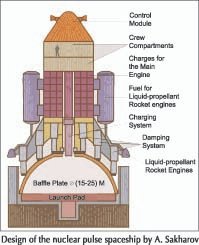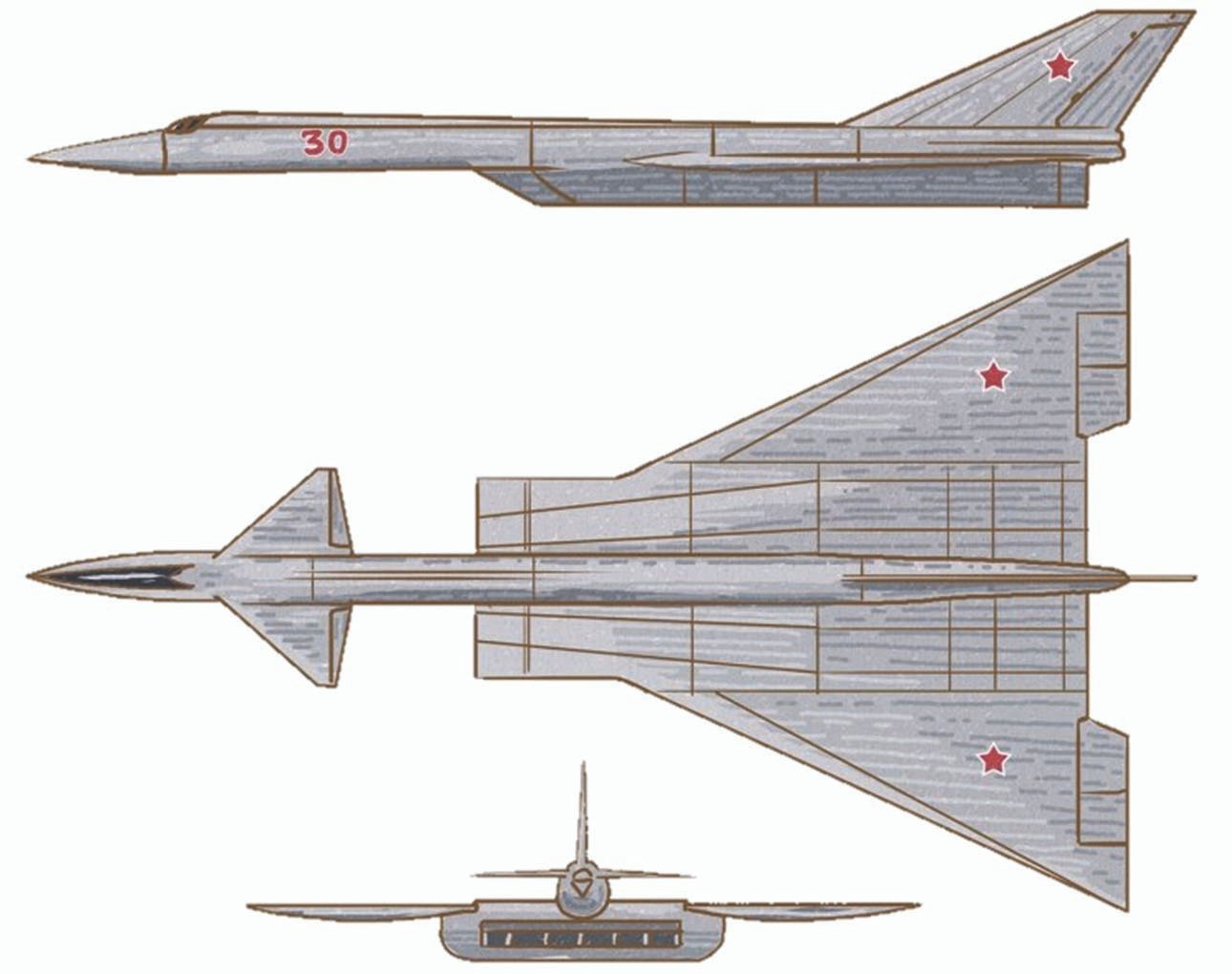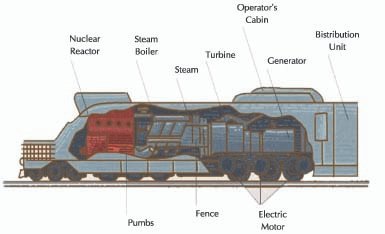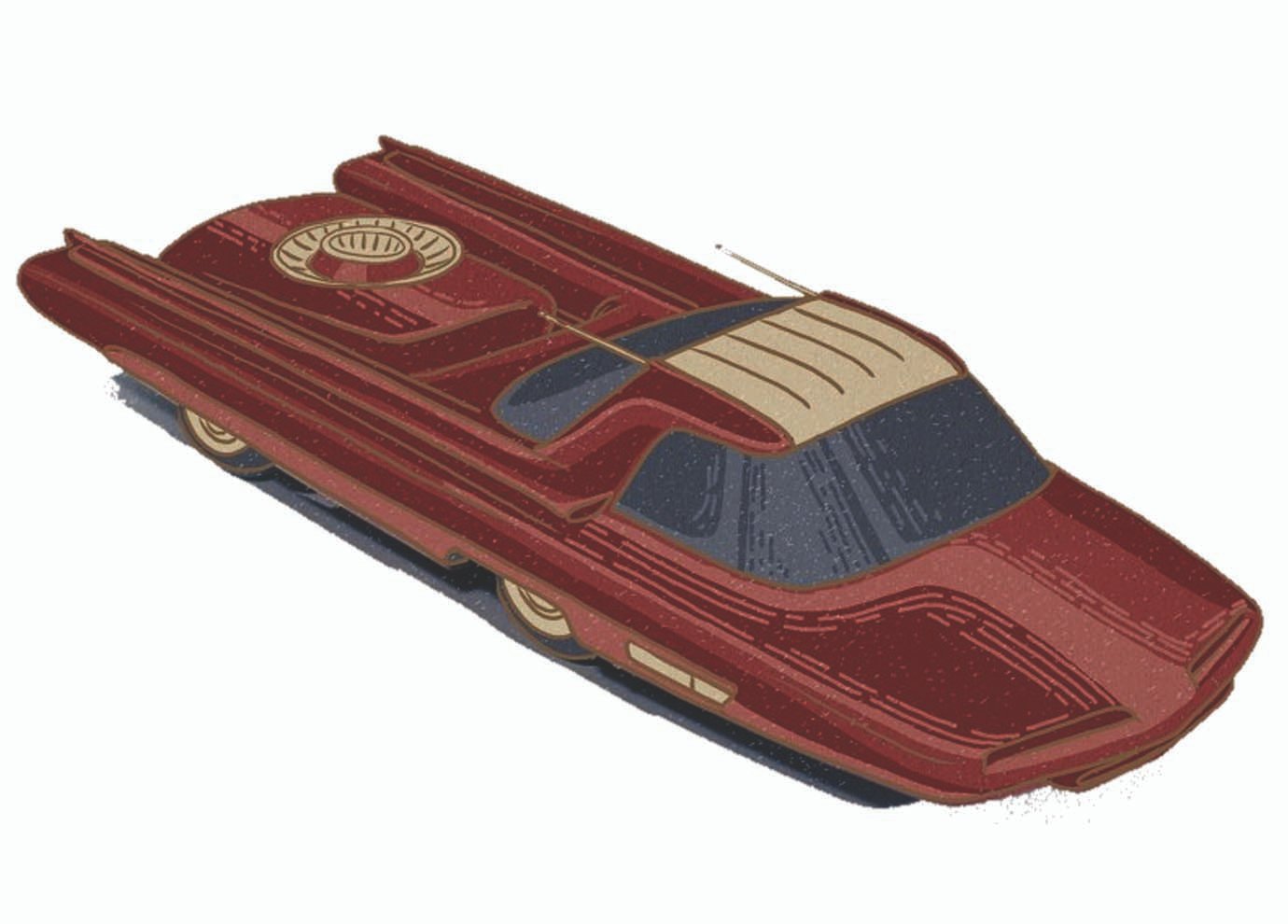
The nuclear energy has always been the source of fire of imagination for scientists for decades. From nuclear-powered rocket engines to an atomic jet plane, the human mind has conceptualized many interesting ways of using nuclear energy. But many of these concepts could not come out of drawing board. Let’s now get introduced to four most exciting ideas of application of nuclear technologies envisaged in the bygone century. They may resemble science fiction at the first glance, but ultimately they make you believe that nothing is impossible.
The Nuclear Pulse Spaceship
A nuclear pulse spaceship is a space vehicle equipped with a pulsed thruster. The lower part of the spaceship contains a thermally-insulated solid metallic disk known as a pusher. Nuclear explosions periodically go off under the pusher, which give the rocket motor impulse. This technology is quite interesting and makes it possible to reach an enormous speed. For example, the US Orion spaceship project envisaged the vehicle’s maximum speed as equal to one-thirtieth of light speed. The Orion would have taken 130 years to reach the nearest star in the Centauri Constellation. The Daedalus interstellar unmanned spacecraft designed by the British Interplanetary Society was supposed to travel three times faster. In the USSR, the Vzryvolyot, or nuclear pulse spaceship, was conceived by the inventor of the nuclear bomb, Academician Andrey Sakharov. He first presented his design of a spaceship powered by the energy of nuclear explosion in 1961.

What was the fate of these projects? Both in the USSR and the US they were shut down, even though the potential for manned flight by such a spacecraft had been demonstrated using a common chemical explosive. But, as usual, material problems arose: what should the pusher be made of, to avoid its evaporation? Even today, the pulsed thrusters are still beyond consideration even in motor engine development. Their time, as well as that of interstellar flight, is yet to come.
Atomic Jet Airplane
In the 1950s, the USSR implemented a number of nuclear jet aircraft projects. Initial design envisaged heating the overboard air inside the reactor. The unmanned winged nuclear aircraft was to be equipped with a ducted jet engine channelling the heated air out through an exhaust opening. As for crew-operated nuclear aircraft, they were supposed to have turbojet and turbofan engines, and the combustor chamber to be replaced with a nuclear reactor.
A prototype MT-35 reactor was developed, a set of ceramic tube-shaped fuel rods was manufactured of Beryllium Oxide and Uranium- di -Oxide and a ground trial facility was constructed. The engineers’ concern was a significant emission of radioactive burned up fractions from the fuel units, which was the principal subject of the ground tests.
At the same time, before any results had come in, a few new “clean” projects were initiated. Heat was to be transmitted from the reactor to the overboard air via a special intercooler. The discharge of such vehicles would not be radioactive.

Design of the M-30 atomic jet aircraft. The reactor is located in the middle of main body with six nuclear turbojets in the rear part
It should be noted, however, that no country has ever managed to produce a full featured atomic jet aircraft. Furthermore, no serious long-term research has been conducted on this matter for almost 50 years. Why? Partly the reason is that, though rarely, airplanes do crash, and in the case of an atomic jet aircraft the consequences of such a tragedy would be worsened by the radioactivity problem.
“Splitting 200 grams of Uranium can provide a nuclear jet engine with 10,000 h.p. for 30 hours (enough, for example, for a flight from Moscow to New York and back at a speed of 1,000 km/h). This would require almost pure Uranium-235,” says statesman Boris Pozdnyakov at a meeting of the Science and Technology Committee of the First Chief Directorate under the Council of Ministers of the USSR in 1947.
Nuclear Locomotive
A nuclear train project was under development from 1983 to 1985 for the purposes of military rocket railway transportation. Later, all activity in this field ceased. One of the reasons was security requirements. A nuclear locomotive that would make the “rocket train” virtually fully autonomous could still have an accident and cause intensive radioactive pollution. In addition, such a heavy machine would require construction of extremely large railway tracks, as well as reinforcement of infrastructure such as bridges, as the existing ones would not have borne such a load.
As a result, no nuclear train, even a trial one, has ever been built. And the future of such projects is quite uncertain.

Single-section arrangement of an atomic locomotive. All components are incorporated in a single body, including a nuclear reactor, a steam generating unit and a turbo generator powering electric motors that make the wheels roll.
Nuclear Car
The brilliant idea to attach a nuclear reactor to a car’s engine has remained a fantasy of its designers.
The most famous example is the Ford Nucleon concept car (1957), which required a replacement of its mini-reactor with a new one every 8000 kilometres.

FORD NUCLEON: a rear view of the reactor
Naturally, Ford hasn’t managed to launch a single working model of the car, not even a prototype. Nucleon can be seen as one of the brightest symbols of the era’s “nuclear romanticism,” when scientists and engineers believed that they had completely tamed nuclear energy.
Andrey Akatov & Yuriy Koryakovskiy;
The authors are senior lecturers at St. Petersburg State Institute of Technology in Russia
E-mail: andrey_akatov@mail.ru



